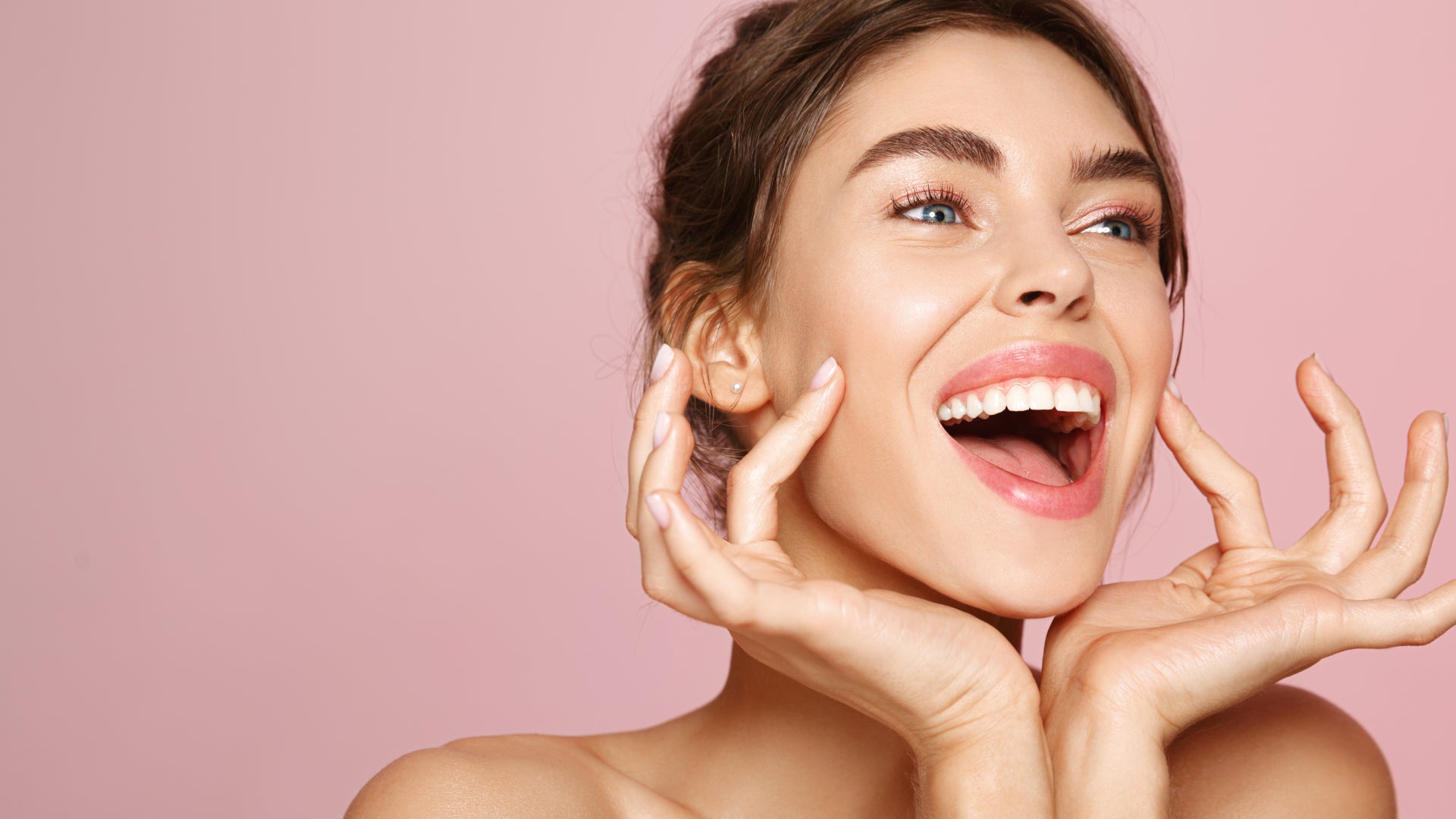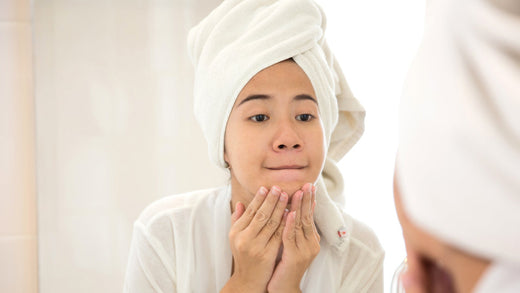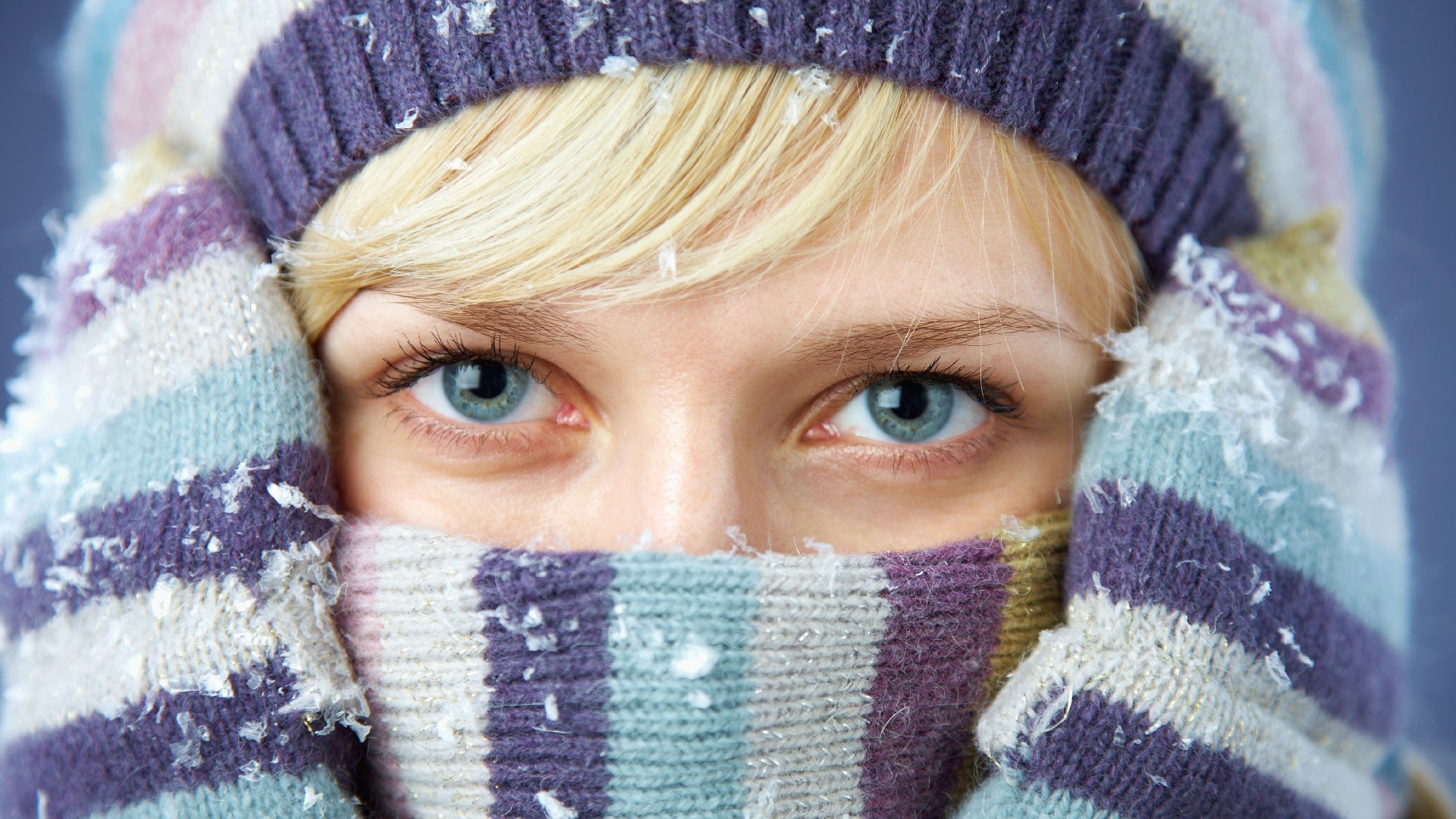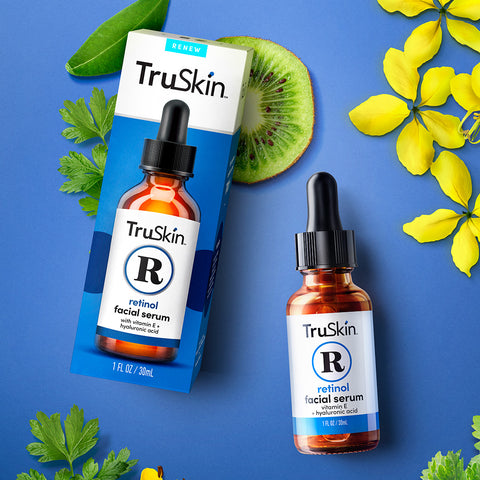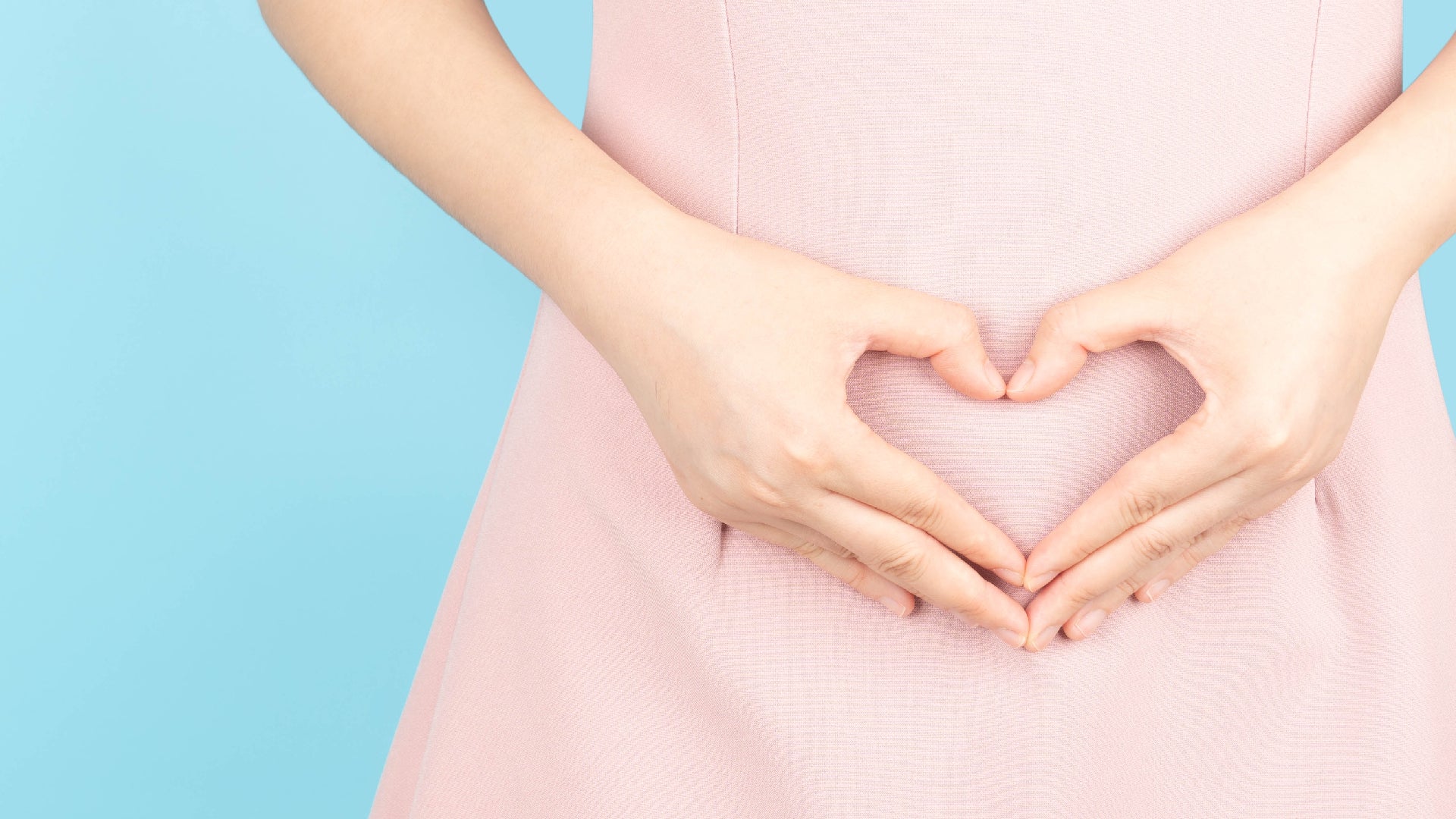
True Radical Honesty From Our Community
What To Do If You Hate Those Fine Lines Around Your Lips
Read MoreAdvice for all of your skin care needs
- all articles
- Acne
- Anti-Aging
- Collagen
- Combination Skin
- Company Announcements
- dry skin
- Exfoliation
- Eye Care
- Facial Redness
- Grooming
- Holidays
- Hyaluronic Acid
- Niacinamide
- Oily Skin
- Retinol
- Sensitive Skin
- Skincare
- Skincare Guide
- Skincare ingredients
- Skincare Routine
- Skincare Tips
- Sun Protection
- Toner
- Vegan Skincare
- Vitamin C
- view all
- Acne
- Anti-Aging
- Collagen
- Combination Skin
- Company Announcements
- dry skin
- Exfoliation
- Eye Care
- Facial Redness
- Grooming
- Holidays
- Hyaluronic Acid
- Niacinamide
- Oily Skin
- Retinol
- Sensitive Skin
- Skincare
- Skincare Guide
- Skincare ingredients
- Skincare Routine
- Skincare Tips
- Sun Protection
- Toner
- Vegan Skincare
- Vitamin C
-
When battling breakouts, what you put on your skin can make or break your complexion. So which ingredients can truly help acne-prone skin and which make matters worse? Let’s find out…
When it comes to the ingredients in your skincare routine it’s important to know if what you’re putting on your skin is doing any good. And if you suffer with oily, acne-prone skin, this is absolutely crucial. Because some ingredients can be a total dream for dry skin... but they're the absolute enemy of pimples and blackheads. They can block your pores, over-stimulate your sebaceous glands and cause all sorts of unwanted side-effects like redness and inflammation.
If you’re stuck in a bit of a breakout zone right now and are suspicious of your skincare routine, here’s a quick guide to some of our favorite breakout-busting skincare heroes… plus a list of some potential villains you'd be wise to avoid.
5 Of The Best Skincare Ingredients For Acne
Acne occurs when an excess of sebum becomes stuck at the surface of the skin where it chokes up your pores and combines with other debris and bacteria. It makes sense, therefore, that your skincare ingredient BFFs include those that balance sebum, increase cellular turnover and reduce inflammation.
1. Salicylic Acid
Salicylic acid is up there as one of, if not the best ingredients for reducing the severity and frequency of acne breakouts. A beta hydroxy acid (BHA), salicylic acid is what’s known as a chemical exfoliant which means it works to break down the bonds between dead skin cells so they’re able to shed more efficiently.
But it doesn’t stop there. BHAs also have another string to their bow because unlike water-soluble AHAs like glycolic and lactic acids, they’re oil-soluble which enables them to help balance your sebaceous glands to reduce excess oil and minimize breakouts. Add to that the fact that salicylic acid has anti-inflammatory and antibacterial properties and there’s very little that can beat it.
2. Tea Tree Oil
Nature also offers some incredible benefits for acne-prone skin, not least of which comes from tea tree oil.
Tea tree oil is one of the most effective oils for reducing acne breakouts because it kills certain acne-causing bacteria that sit on the surface of the skin. When that kind of bacterium gets left to its own devices, it blends with excess sebum, congests your pores and the inevitable happens lightning fast.
By treating your skin with a thoughtfully crafted tea tree oil formula (applying it neat is not advised) it will also work to calm inflammation and minimize the other visible effects of acne, namely redness and irritation. It’s kind of like the natural alternative to benzoyl peroxide – with fewer side effects.
3. Retinol
Retinol is usually thought of as the queen of aging treatments. But it’s also fabulous for fighting acne. A derivative of vitamin A, retinol helps boost collagen and increase skin turnover. It has a similar end result to exfoliation but instead of removing dead skin cells at the surface it activates specific genes at a deep cellular level, encouraging the cells to turnover quicker and more efficiently.
Cell turnover often goes awry in acne-prone skin so retinol keeps things ticking over nicely, helping to prevent blocked pores and thus reduce breakouts and minimize scarring.
4. Bakuchiol
Say hello to bakuchiol, another effective skincare ingredient from nature. Often referred to as the natural alternative to retinol, bakuchiol is extracted from the leaves and seeds of the babchi plant and has been proven to offer almost like-for-like benefits as its vitamin A counterpart.
Is it as kick-ass as retinol? Yes and no. It’s a much milder alternative, for sure, so it definitely takes a little longer to reap the same benefits as you’d get from a similar retinol-based treatment. However, its mildness means it’s much better tolerated by sensitive skin which means it's more likely to be applied consistently.
Both are fantastic in their own special ways, so our advice? Try them both (although not at the same time!) to help you decide which is best for you.
5. Niacinamide
Active ingredients can often irritate sensitive skin so it’s important to go carefully with what you put on your skin, especially during periods of breakouts when your skin is delicate and potentially inflamed.
If your skin falls into that sensitive camp, we recommend niacinamide.
A gentle giant among the skincare greats, niacinamide (vitamin B3) is extremely effective for sensitive skin that’s prone to breakouts. Not only does it help strengthen the barrier function and regulate sebum production but it also works hard to reduce inflammation and redness while aiding repair and reducing the appearance of existing scars and discolorations. Another thing: niacinamide plays well with other acne-fighting ingredients like salicylic acid making it a great way to tackle things head on without causing your skin to freak out.
3 Of The Worst Skincare Ingredients For Acne
Your biggest enemies? Harsh ingredients that dry out the skin and over-stimulate the sebaceous glands. Oh, and anything that ranks high on the comedogenicity scale. More on that to follow…
1. ‘Bad’ Alcohols
Certain alcohols like cetyl and stearyl alcohols have a rightful place in the skincare world. But many of them don’t. Low molecular alcohols like denatured alcohol (aka alcohol denat), ethanol and isopropyl alcohol, for example, are really no good – for any skin type. They can be super irritating and extremely drying on the skin which has the reverse effect on oily skin types, making the sebaceous glands produce even more oil to overcompensate for that which has been lost. When your skin produces too much sebum it clogs up your pores… and the rest is history.
2. Heavy Occlusives Like Cocoa Butter
While excellent at moisturizing, occlusives are ingredients that form a protective barrier over the surface of the skin, trapping in water and keeping dry skin moisturized. If you have oily or acne-prone skin, however, occlusives are the absolute enemy because their thick, waxy composition makes them comedogenic. This means they have the potential to plug the pores and encourage pimples as quick as a flash. Other occlusives include mineral oil, coconut oil, beeswax and lanolin. Don’t go there.
3. Sodium Lauryl Sulfate (SLS)
Have you ever been so good at something that it's seen as a disadvantage? No? Well, that’s exactly what SLS – and its buddy SLES (sodium laureth sulfate) – is. As two of the most powerful cleansers around, these sulfates clean so well that they often strip all the goodness from your skin which disrupts the skin’s protective barrier. This can leave your skin feeling squeaky clean, for sure, but also completely parched. Even irritated and inflamed. We do not advise them for skin that breaks out. The good news is, our cleansers contain neither.
Wanna Take Control Of Acne? These Are The Ingredients To Embrace (& Avoid!)
read more -
If you suffer with regular breakouts we bet you often wonder about the best skincare ingredients for acne. Well, wonder no more, we got you.
Acne breakouts, whatever your age, are no joke. They can be frustrating, confidence-destroying, challenging and sometimes downright painful. Nobody wants that. But sometimes life just deals you a bad hand, and being prone to breakouts (or not) is exactly that. You don’t get pimples, blackheads and whiteheads because you have poor personal hygiene or eat too much chocolate. You get them because your genes dictate the makeup up of your skin and, in this case, are encouraging it to produce too much oil. This excess oil (or, more specifically, sebum) then teams up with dead skin cells and bacteria to have a party in your pores, leading to all sorts of congestion and potential breakouts.
Granted, it’s all well and good knowing your pimples aren’t your fault, but this doesn’t make them go away. So what can you do to control oil production, balance your skin and help keep zits from upsetting your mojo? Well, understanding what you put on your skin and, more specifically, knowing which skincare ingredients mean business is a great place to start.
Behold the best ingredients for acne-prone skin – in our (and most skin experts') humble opinion.
Tea Tree Oil
Tea tree oil is an essential oil that’s steam distilled from the leaves of the melaleuca alternifolia (tea) tree. Chock full of antibacterial and anti-inflammatory qualities, it’s been used for centuries to heal the skin, and as an acne-fighter, it’s pretty unstoppable.
Exactly how does tea tree oil work on acne? For starters, it works hard to kill certain acne-causing bacteria that sit on the surface of the skin. Couple this with its ability to calm redness, reduce swelling and soothe irritation and it becomes a great choice for anyone wanting to deal with breakouts with a natural, effective skincare ingredient.
Word to the wise, however, tea tree oil is full-on potent so you should never apply it in its purest form. Instead, leave it to the pros to curate an effective formulation you can use every day.
Salicylic Acid
Keeping your skin ticking over is super important if you’re susceptible to the slings and arrows of blocked pores and acne breakouts. When your skin fails to turn over at a reasonable rate, dead skin cells get stuck at the surface, where they love to hang out in your pores causing total havoc.
As you may know, the rate at which your skin turns over seriously slows down as you get older. This is why it’s super important to kick-start this process with exfoliation. Scrubs are great for removing dead skin cells and encouraging the skin to turn over more efficiently, but to really tackle acne-prone skin, your best bet is to choose skincare containing salicylic acid.
Salicylic acid is a beta hydroxy acid (BHA) which means it’s a oil-soluble chemical exfoliant. Hydroxy acids work by breaking down the bonds between your skin cells so they slough away easily and make way for the new stuff. However, unlike glycolic acid, which is a water-soluble alpha hydroxy acid (AHA), BHAs cut through grease which gives them the extra edge with oily skin, allowing them to truly work on your sebaceous glands and balance oil production.
Another point in salicylic acid’s favor? It has anti-inflammatory and antibacterial properties. And if you have angry pimples or facial redness, you’re so going to want to get in on that.
Try: 6% AHA, BHA + PHA Liquid Exfoliant
Retinol
A go-to in the skin aging world, retinol, a topical form of vitamin A, also offers some pretty impressive results for acne-prone skin. Who knew? Well, we did, but then again that’s what we’re paid for!
Similar to exfoliating acids – although it works very differently to salicylic acid and friends – retinol promotes cell turnover to ensure your pores stay clear of unwanted dead skin cells. Instead of breaking down the bonds between dead skin cells, however, retinol works by attaching itself to nuclear receptors in the center of each living cell where it activates certain genes to accelerate turnover.
It might not be the most obvious choice for when your skin breaks out, but use it on a regular basis and it’s been proven to reduce the frequency and improve the severity of breakouts. Plus, if you’re of a certain age, you get all the added age-fighting benefits as an added bonus. Put like that, it seems silly not to.
Try: Retinol Moisturizer
Niacinamide
If you’re stuck with the double-whammy of acne and sensitive skin, you’ll know only too well how difficult it is to find skincare formulations that improve your breakouts but don’t irritate your skin. The struggle is real. However, it’s not impossible. And one ingredient that should top your must-tries? Niacinamide.
Niacinamide (vitamin B3) is one of the most effective active ingredients for sensitive skin. It also makes the list for best ingredients for acne-prone skin. And that’s no mean feat.
As well as being one of our favorite antioxidants, working hard to counteract the damaging effects of environmental free radicals, niacinamide also increases the production of ceramides in the skin’s uppermost layers. Ceramides enable the skin to remain strong, supple, hydrated and able to protect itself from unwanted irritation. Sweet.
But what about acne breakouts? Which is why we’re here, after all. Well, niacinamide has been proven to reduce inflammation (check), regulate sebum production (check) and it can even help minimize the appearance of enlarged pores when used regularly and together with a great cleansing regime. Research also shows it may have antimicrobial effects, helping to destroy acne-causing bacteria that may be lurking in your skin’s microbiome. Hells yeah!
Try: Niacinamide (B3) Facial Serum
Finally, A Few Important Things To Remember
1. Always patch test new ingredients on a small area of skin before regular, all-over use. Not sure how to do this? No problem, here's a guide on how to patch test your skincare products.
2. Introduce potent, active ingredients gradually into your skincare regime. Start once or twice a week to begin with, then build slowly as your skin acclimates. This will allow the product to work its magic with fewer risks of irritation.
3. Apply broad-spectrum sunscreen every day, without fail. Active ingredients encourage fresh skin cells to the surface, so they need extra TLC to protect them from UV damage. No arguments.
4. Don’t expect miracles overnight. Skincare formulations that treat at a deeper level aren’t an immediate fix so be patient and give them the time they deserve – two to three months is usually the sweet spot.
5. Skincare alone may not be enough to manage persistent or severe acne, so consider seeking professional help from a dermatologist if yours simply won’t go away.
Acne-Fighting Solutions That Get The Job Done
read more -
No idea why you’re getting an influx of acne right now? Many lifestyle habits can trigger your breakouts – and sometimes they’re found in the most unsuspecting places.
As you know, acne is caused by one thing and one thing alone: an excess of sebum that causes your pores to become blocked with oil, dead skin cells, bacteria and other impurities. Eating too much chocolate doesn’t give you pimples. Neither does moisturizer. Sure, they can trigger breakouts if you’re genetically susceptible to them, but acne isn’t caused by uncleanliness, a poor diet or crummy skincare routine. It’s caused by blocked pores. End of.
OK, so this begs the question: why bother trying to cure them if your breakouts are totally out of your control? Well, here’s the thing. You can’t change your genes, that’s for certain. However, what you can do is keep acne-triggering factors under control to help lessen the blow. Sleeping well, reducing emotional stress and eating a healthy, well-balanced diet; all these things are important for maintaining balanced sebum and therefore reducing the likelihood of you breaking out week after week.
But there are also some less obvious reasons why you face might be suffering with regular breakouts. So if you’ve already dispensed with things like smoking, poor cleansing and too much exfoliation, but you’re still getting pimples on the reg, it might be time to look at some of the more unexpected areas of your life.
On that note, read on for five slightly more unusual causes for your breakouts.
1. Your Pillowcase
Getting enough beauty sleep is crucial for the health of your skin, but if you’re sleeping on a dirty pillowcase for a solid eight hours every night dirt and bacteria is inevitably going to build up and irritate your pores. This is especially true if you sleep on a synthetic pillowcase because man-made fibers don’t absorb sweat as effectively as natural fibres like cotton or linen.
The answer? Go natural all the way, for starters. Also, cleanse and moisturize your skin before bed to reduce the amount of grime getting on your pillowcase. Tea Tree Super Cleanser+ is a great acne-fighting cleanser that balances and clarifies your pores. Follow this with Retinol Moisturizer to lightly hydrate and moisturize your skin while boosting cellular turnover to keep your pores free of dead skin cells.
Finally, wash your pillowcase every three or four days. And ditto, your face towel. Old, dirty towels that are used by the whole family for drying their hands and who-knows-what-else are another breeding ground for germs and bacteria. Do you really want to be swiping this all over your freshly cleansed skin? Thought not. So, invest in a couple of cotton face towels for you and you alone and wash them every other day.
2. Your Makeup & Hair Products
Your skincare routine might be spot on, but what about your makeup and hair products? Rich hair conditioners, for example, are notorious for containing heavy ingredients like cocoa butter and coconut oil which, granted, are incredible for moisturizing your precious locks, but are not so great for acne-prone skin. Of course, we know you’re not smothering your face with conditioner but still, it can settle on your face when you rinse your hair so always cleanse your skin after, never before conditioning.
Makeup can similarly clog up your pores, especially if you use formulations that contain oil. So don’t do that. Instead, look out for noncomedogenic products (this means they’re less likely to block pores) and use powder rather than liquid formulations whenever possible.
3. Your Workout Routine
Do you love to get a good sweat on when you’re working out? High fives to you. However, allow all that sweat and grime to sit on your skin and your pores are going to clog up quicker than your instructor can say ‘hit the floor for ten push-ups.’
Cleanse your skin thoroughly and swiftly after exercising (the longer you leave your skin doused in sweat and grimy workout gear, the more bacteria is likely to breed), and always use a mild but effective cleanser that helps to detoxify your skin without drying it out. Our Charcoal Clarifying Cleanser is a goodie as it harnesses the powers of coconut-derived activated charcoal which destroys skin-smothering impurities to offer a deep, gently purifying clean every time.
4. Your Winter Cover-Ups
Any fabric that rubs against your skin can lead to unwanted issues in the long-term. Remember how face masks were causing ‘maskne’ back in the pandemic? This was all due to friction from the mask combining with the obvious culprits of sweat, dirt, oil, bacteria and humidity which caused dryness, irritation and pimples.
Thankfully, for most of us, the days of having to wear a mask 24/7 are over. However, if you spend a lot of time outdoors in the winter and like to wrap yourself up in woollen hats and thick, heavy scarves, these can cause similar problems, trapping sweat and increasing friction around your chin, jaw, neck and forehead.
To help reduce breakouts caused by beanies, scarves (and even turtleneck sweaters), avoid synthetic fabrics and launder your winter cover-ups regularly. Weekly, at least.
5. Your Laundry Detergent
Speaking of laundry, your choice of detergent is also imperative. Just like your beauty routine, certain ingredients in your laundry detergent can be super irritating – especially if you have extremely sensitive or acne-prone skin. Fragrance, for example, can be a real Debbie Downer, as can harsh dyes, essentials oils, strong surfactants and preservatives.
To reduce the likelihood of your laundry detergent triggering those pesky breakouts, first up, choose liquid over powder detergents. Why? Because these leave behind less residue on your clothes and fabrics (who knew?!). Also, never use more detergent than is recommended on the label, avoid fabric softeners and try double rinsing your laundry after washing to remove as much residue as possible.
5 Unusual Things That Can Trigger Breakouts
read more -
Adult acne might feel and look the same as teenage acne but when it comes to nailing an effective, breakout-busting skincare routine, it’s a whole different beast.
As if fine lines, wrinkles and all the other signs of skin aging weren’t enough to contend with, there’s also that crazy little thing called adult acne. Acne ‘should’ be something that you say farewell to as you come to the end of your adolescent years and your hormones settle into adulthood. But that’s not always the case. In fact, adult acne is on the increase and it’s estimated to affect more and more adults as they hit their 50s and older.
What Is Adult Acne?
Acne vlugaris, the proper name for the type of acne we’re dealing with here, is exactly the same at any age. It rears its head when your hair follicles and pores become blocked with excess oil and dead skin cells. Unlike regular teenage acne, however, the adult kind can be split into two different types: persistent acne and late- or adult-onset acne. Persistent acne continues from adolescence, never really giving you a break, whereas late-onset acne is the stuff that appears for the first time later on in life. Just when you thought you’d gotten away with it. Dang!
This all sounds pretty simple, but things get a little more complicated from here on in. How so? Because acne can take on many forms. If the plug bulges out above the surface of your skin it creates a whitehead, for example. If the plug opens up, it oxidizes with the air, turns dark and creates a blackhead. And if bacteria gets involved and infects the blockage? Then it becomes a full blown zit – a papule, pustule, nodule or cyst, if you will.
So, Why Do Some People Get Adult Acne While Others Don’t?
As a rule, acne is genetic, so if you’re predisposed, thanks to your parents, there’s not much you can do about that. What you can do, however, is to understand what’s triggering these breakouts later in life – hint: more often than not, it’s your hormones. During menopause, for example, your hormones are all over the place and if you’re sensitive to these triggers, this creates an imbalance that causes sebum production to go wild and your your skin to completely freak out.
Emotional stress and certain medications can also overstimulate your sebaceous glands, as can pore-blocking or harsh ingredients in your skincare regime.
On that note, here’s how to create a kick-ass skincare routine that cares for your adult skin (aka doesn’t dry it out!) and helps to balance oil production to keep breakouts to a minimum.
The Best Morning Skincare Routine For Adult Acne
1. Gently Cleanse Your Face
For some, a morning cleanse can seem a little OTT when all you’ve done is sleep since your last cleanse. Not so for you. Because your skin is oilier than most you’re going to want to gently remove any sebum that may have built up overnight. Also, your night cream might feel kind of heavy for daywear, so it’s good to start with a clean slate in the AM.
One word of warning: don’t fall into the trap of grabbing the most skin-stripping cleanser you can find. You can just about get away with that when you’re 13 – although it’s never ideal – but when your skin is more mature it’s going to need way more care. Choose something that will help replenish your barrier function, soothe and calm inflammation and cut out any risk of over-cleansing your skin. A product like our Soothing Cleansing Milk is great for morning use.
2. Balance Your Skin With Tea Tree Oil
As you know, we’re massive fans of face serums for targeting skin issues exactly where they’re needed, and when it comes to adult acne, our favorite topical ingredient is tea tree oil.
Unlike other acne-busting favorites like benzoyl peroxide, tea tree oil is less drying and irritating on the skin which makes it a great choice for mature skin. But don’t think that means it’s any less effective because its antifungal, anti-inflammatory and antimicrobial properties combine to give it true superpowers in the fight against bacteria and acne breakouts.
Try applying our Tea Tree Super Serum+ two or three times a week after cleansing and before moisturizing to help balance and calm your skin. We like to alternate it with Niacinamide (B3) Facial Serum which is another winner for regulating oil and reducing inflammation.
3. Lightly Moisturize
Moisturizing oily, acne-prone skin might seem counterintuitive but it’s actually crucial for keeping your barrier function healthy and keeping sebum under control. If you miss this step, your sebaceous glands will think your skin is dry and thus overcompensate with more oil.
Avoid thick creams that are jam-packed with heavy occlusives like cocoa butter, however – these will block your pores and cause no end of problems. Instead, stick with light gel or lotion formulas that incorporate hydrating ingredients like glycerin, aloe and hyaluronic acid. Our Firming Collagen Day Lotion is great for oily skin, plus it helps tackle the visible signs of aging at the same time. Result.
4. Apply Sunscreen
UV radiation will make acne (and any potential scarring) worse. Not to mention all the other dastardly deeds it gets up to as the sun beats down on your skin on a daily basis.
Wear sunscreen every day, without fail, and always choose a broad-spectrum formula with SPF 30 or above. And if you really can’t bear the thought of applying moisturizer AND sunscreen? Try our SPF 20 Mineral Sunscreen with Vitamin C. It’s packed with hydrating and moisturizing ingredients which are probably just right for your oily skin.
The Best Nighttime Skincare Routine For Adult Acne
1. Remove Makeup & Cleanse Your Face
Before bed is when a more thorough (but still not too full-on) cleanse comes into play. Your evening cleanse is way more important than the morning one because this is when your skin has been subjected to at least 15 hours worth of makeup, sunscreen, dirt, oil and pollution. And if you don’t whisk that away it can, and will, build up on your skin where it will combine with dead skin cells and sit in your pores waiting for the worst to happen.
We recommend our Charcoal Clarifying Cleanser or Tea Tree Super Cleanser+ which both work hard to whisk away debris from the surface of your skin while balancing, detoxifying and refreshing your complexion.
You should also exfoliate once or twice a week to gently boost cellular turnover and minimize any risk of dead skin cells hanging around for too long. Try our Vitamin C Gentle Face Scrub after cleansing.
2. Treat Your Skin With Retinol
Retinol might be the gold standard of aging treatments, but it’s also right up there in the fight against adult acne. A derivative of vitamin A, retinol helps to increase cell turnover. It’s a little bit like exfoliation, although it works in a very different way. Instead of removing dead skin cells at a surface level, retinol goes deeper into the skin and activates certain genes to accelerate cell turnover down below. It’s very clever and a great way to keep dead skin cells moving along so they don’t clog up your pores. This is music to the ears of mature, acne-prone skin – especially when you add in all the other age-defying benefits retinol brings to the table.
Just remember, retinol is very powerful, so start slowly by applying Retinol Facial Serum just once or twice a week to clean, dry skin. Then, as you build tolerance, you can build up to every night.
3. Hydrate & Moisturize
Allow your serum to sink in for a minute or two, then finish with moisturizer. Of course, you can double up with the same product you used in the morning, but you might find your skin needs a little more moisturization at night.
Our fabulous Retinol Moisturizer is a great product to apply before bed as it combines retinol with hydrating hyaluronic acid, soothing vitamin E and plumping panthenol. If the combination of this and the retinol serum is too much for your skin, however, try our Longevity duo: Rejuvenating Longevity Serum followed by Renewing Longevity Moisturizing Cream. Both of these formulations are incredible for aging skin that gets a little, shall we say, problematic. They harness the powers of bakuchiol, which is nature’s kinder alternative to retinol.
The Ultimate Skincare Routine For Adult Acne
read more -
They might not be inflamed like pimples, or ‘dirty’ looking like their blackhead cousins, but nobody wants to deal with whiteheads.
Whiteheads can plague pretty much any skin type and can strike at any time of your life. But, like any type of acne, all is not lost when you’re armed with intel (and intel is incoming, don’t you worry), patience (sorry, we can’t help with that one) and the right tools to help eliminate those pesky skin bumps. Those, we can also do.
Here's everything you need to know about whiteheads, including what they are, what causes them and how to win the battle… as well as the war.
What Exactly Are Whiteheads?
Like pimples and blackheads, whiteheads are a form of acne most often found on the face, back or chest. According to the AAD, acne is the single most common skin condition in the country, affecting around 50 million people every year and often continuing from adolescence into adulthood. So, remember, if you’re suffering right now, you are not alone.
Acne, in all its various shapes and sizes, occurs when sebum and dead skin cells collect at the surface of the skin, clogging up the pore and forming a kind of hard plug that makes said pore swell and become raised.
What happens next determines the type of acne that rears its ugly head (or not, as the case may be!)… If the pore stays closed, it produces a white or pale yellowish bump called a whitehead. If it opens at the surface and becomes exposed to air it oxidizes, turns dark and becomes a blackhead. And if it becomes inflamed it becomes what we regularly refer to as a pimple. Pimples range in severity and can be pretty innocent (pink and tender) to extremely angry, painful and filled with pus.
All fun stuff. Not!
So, What Causes Whiteheads?
Contrary to many ridiculous old wives’ tales, whiteheads are not caused by chocolate or poor cleansing habits. Same goes for any type of acne. Their cause is solely thanks to excess sebum combining with keratin and dead skin cells. This little cocktail of 'gunk' then gets stuck in your pores and results in all sorts of acne-related problems.
However, there are many triggers and lifestyle factors that increase your risk of developing whiteheads. Your genes, for one thing (darn those parents of yours!). Then there are other factors like heavy, buttery moisturizers which can sit on the surface of your skin and block your pores; a diet that’s high in sugar and processed carbs, and wayward hormones – which is why puberty, menstruation and the menopause are such major times for breakouts.
5 Of The Best Ways To Deal With Whiteheads
So, what can you do to help prevent clogged pores and help stop whiteheads in their tracks? And what about when they still manage to break their way through your smooth complexion? What can be done then? Well, here are five of our favorite ways to cope with whiteheads.
And PS: if blackheads and pimples are more your jam, these tips work across the entire acne board. You’re welcome.
1. Never Squeeze Your Whiteheads
Yes, it’s tempting and weirdly satisfying to prod, poke, pick and squeeze whiteheads. But don’t. This can spread bacteria which, in turn, makes matters far worse in the long run. It can also lead to scarring. Which is not cool.
Whiteheads tend to disappear and heal much faster if you keep your fingers away. However, if it does look ready to pop, you can apply a warm flannel then gently press the surrounding skin away (not towards) the whitehead to help it drain. A gentle touch is the key here, however, and if it nothing shifts, leave well alone and let nature take its course.
2. Know That Regular Cleansing Is Vital
The best way to stop sebum (and other debris like makeup and sweat) from building up on the surface of your skin? Easy, a good cleansing routine. Of course, stripping your skin of every last drop of oil and moisture will make your skin flare-up even more, so don’t go down that road. It’s so 80s!
Instead, choose finely balanced cleansing products like Tea Tree Super Cleanser + which contains purifying, acne-busting goodies like tea tree oil and witch hazel, combined with healing champs like MSM and chamomile, and hydrating wonderkids like aloe vera and botanical oils.
Cleanse every morning, every night and again after working out (one word: sweat!), using warm, not hot water and concentrating on any problematic areas like around your nose and over your forehead. You won’t see results immediately, but trust us, make this cleansing routine a daily habit and your skin will soon thank you.
3. Add A Little Retinol To Your Night Time Routine
Retinol is the gold-standard of anti-aging skincare. But did you know it also makes for a pretty mean acne-fighting machine?
Retinol is an over-the-counter derivative of vitamin A that increases cell turnover by attaching itself to nuclear receptors in the center of your cells. Without getting too technical, this is where genetic information is stored and where major cellular functions are processed. Once attached to these receptors, retinol activates certain genes to accelerate cell turnover and help encourage dead skin cells to shed more efficiently. This helps keep your pores from clogging up and breaking out. Pretty neat, huh? As you can probably guess, we’re big fans over here.
Try our Retinol Facial Serum or Retinol Moisturizer if you want to get in on the action.
Just remember, as great as retinol is, it’s very potent and extremely active, so always patch test any new product first, then start using it slowly by applying it just two or three evenings a week to clean, dry skin. As you build tolerance, you can then work up to nightly use.
4. Avoid Abrasive Scrubs & Harsh Chemicals
Like squeezing whiteheads, it’s tempting to want to throw all sorts of scrubs, astringent lotions and products that contain drying alcohols at them. Massive mistake. This can seriously compromise your skin’s barrier function which invites all manner of other issues to the party. Think irritation, redness, itching and all sorts. Remember, skin-friendly, plant-powered products are always best.
5. Embrace The Powers Of Salicylic Acid
Exfoliation is super important for ensuring those dead skin cells don’t get stuck at the surface of your skin. But you’ve got to be kind as you exfoliate because too much can over-stimulate your sebaceous glands and can make matter worse.
Instead of harsh scrubs, we recommend sticking with exfoliating acids that work specifically on breaking down dead skin cells, without any need for unnecessary pressure or friction.
Salicylic acid, for example, is a total shoo-in for oily, problematic skin as it not only dissolves the ‘glue’ that binds dead skin cells together, but it’s oil-soluble which means it’s able to penetrate into your sebaceous glands to loosen sebum and unblock pores. We combine this oily skin hero with all manner of balancing, brightening and soothing ingredients in our 6% AHA, BHA + PHA Liquid Exfoliant. We recommend you add to cart immediately.
Still not able to get on top of your whitehead situation? Then check-in with a skincare professional for further advice and/or recommendations. There are plenty of options out there, from hormone therapy to laser treatments, so don't lose heart, you've got this.
The Best Ways To Treat Whiteheads, Once And For All
read more -
Been hearing a bit about the gut-skin axis recently and not sure what it’s all about? Then allow us to elaborate…
When searching for the solution to monthly acne breakouts, eczema flare-ups or bouts of rosacea few people think about what’s going on inside their bodies. But rather than stock up on months of prescription medication to deal with your skin issues, word is that taking a look at your gut health could be far more beneficial.
It’s all about the gut-skin axis, you see. The gut-skin, erm, what? Ha, don’t worry, the gut-skin axis is a relatively simple concept to grasp.
Your gut is home to a complex microbiome in which gazillions of microorganisms such as bacteria and viruses live. We know this doesn’t sound pleasant, but your microbiome plays an extremely important role in keeping bad bacteria at bay and therefore keeping your immune system in check. And all this is vital for helping to maintain balance and harmony throughout the entire body.
If this microbiome becomes unbalanced due to things like a poor diet, emotional stress, or food sensitivities, however, this can cause major disruptions in your body. And we’re not just talking about digestive issues like bloating or gastrointestinal diseases, because wherever there is gut inflammation, skin inflammation often follows.
Why is your skin affected by your gut, you might be wondering? Well, just like your gut, your skin has its own microbiome and the two are in constant communication with each other via a clever little pathway called the gut-skin axis. This means that when your gut is off kilter, your skin will, more often than not, reflect this, becoming inflamed, irritated or congested. Eating dairy, for example, is often linked to chronic skin issues like eczema. Wheat is another one that’s known to cause sensitivities and congestion, thereby triggering acne.
Reckon your gut could do with a little self-refinement right now? Here’s how to help improve the health of your gut… and consequently, your skin.
1. Get An Allergy Test
The most effective way to figure out what’s upsetting your gut and skin is to get an allergy test. Sure, you can do this at home by keeping a food diary while eliminating some of the main offenders (here’s looking at you dairy, wheat, gluten and spicy foods), but, jeez, do you really have the time, energy and patience? Thought not.
A better option is to visit a specialist to get a food allergy test. There are many ways to go about this but the most common are skin prick tests and blood tests. Both of these are very useful ways to pinpoint what’s causing you grief. Then you can avoid the culprits. Simple.
2. Cut Down On Sugar
While we would never suggest you remove things like dairy and wheat from your diet without consulting a doctor or allergist first, one thing you should be extremely wary of is sugar. With zero nutritional value, sugar is dastardly for your gut and even worse for your skin, triggering everything from acne and eczema to rosacea and psoriasis. In fact, sugar is probably the most inflammatory thing you could put into your body. Eek.
Furthermore, studies show that overloading your body with sugar produces advanced glycation end products (AGEs) – harmful compounds that break down collagen and elastin and ruin your radiant, youthful complexion.
Sugar is officially bad news, whichever way you look at it.
3. Eat Plenty Of The Good Stuff
A healthy diet is everything, so once you’ve eliminated anything that’s causing your gut grief, it’s time to indulge in all the good stuff. Fresh fruit, veggies, nuts, beans, healthy fats and lean protein are all awesome ways to support the wall of your gut.
And then there are those extra special foods that help promote good bacteria in your gut, and of course your skin as a consequence. These are called biotics – namely prebiotics and probiotics.
Biotics help balance your microbiome by literally flooding it with good bacteria. Prebiotics help encourage the growth of healthy bacteria that’s already present in your gut and can be found in things like asparagus, artichokes, garlic, leeks, bananas and oats. Meanwhile, probiotics are microorganisms in their own right and are found in cultured and fermented food like kimchi, sauerkraut, kombucha, kefir, miso and live yogurt.

4. Minimize Stress
When you’re stressed out your brain goes into fight or flight mode and triggers your nervous system to release a whole bunch of hormones like cortisol and adrenaline into the bloodstream. This causes your heart to pump faster, your breath to quicken and your muscles to tense and get ready for action.
Of course, this is pretty useful when your body needs to react quickly to something, but the problems arise when stress hormones go into constant overdrive and your body gets no time to relax or go back to normal. This plays havoc with your gut (among other things!), compromising the balance of its microbiome, ‘feeding’ the bad bacteria and causing major problems with your digestion and immune system.
All this will reflect very poorly on the look, feel and health of your skin so try to cut down on stress wherever you can. This may be easier said than done, but there are many ways to reduce or manage your levels of stress. Some people find that yoga or exercise works. Others keep a stress journal to figure out what’s causing their stress in order to avoid their triggers and help them work on controlling their reactions. The most important thing, according to HelpGuide, is to experiment with different stress management tips to find what works for you.
Once your gut is in a more healthy working order, trust us, your skin will start to follow suit.
And in the meantime, ensure you’re doing everything you can to keep it clean, strong, protected and moisturized with your TruSkin favorites! Here’s how to build a successful skincare regime, right here.
How A Healthy Gut = Healthier Skin
read more



